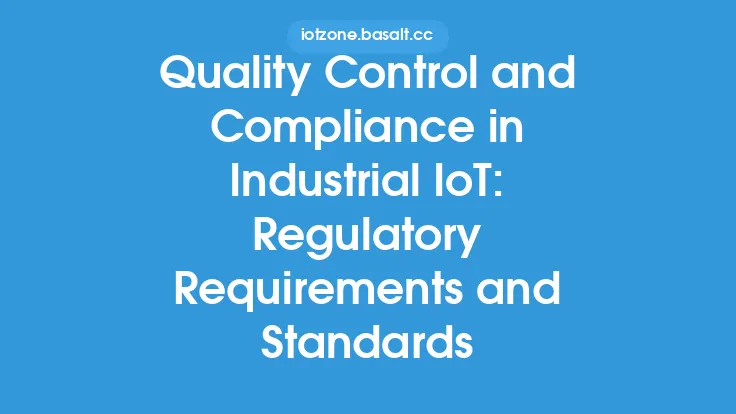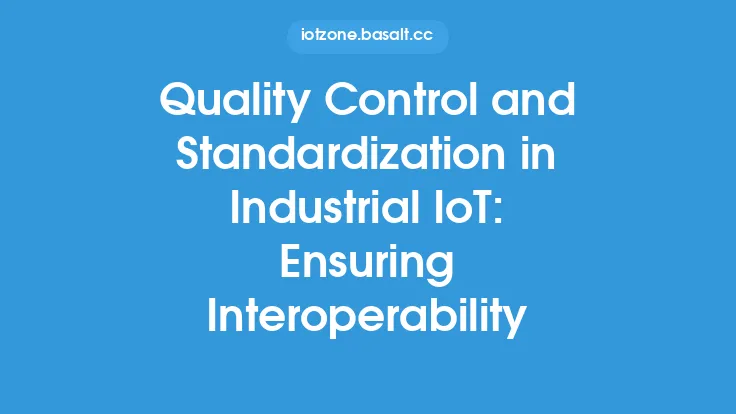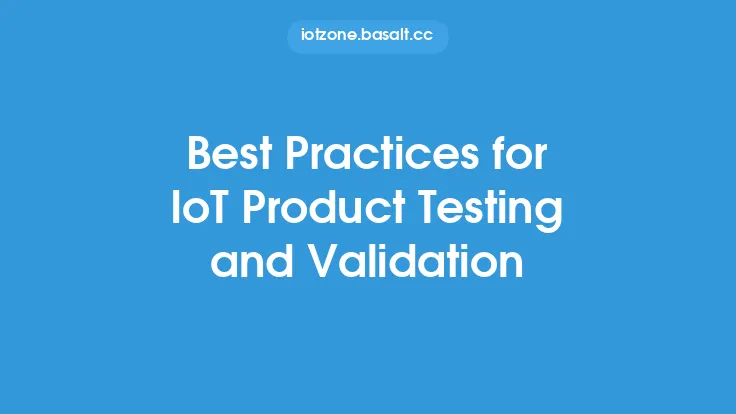The Industrial Internet of Things (IIoT) has revolutionized the way industries operate, with a vast array of devices and sensors being deployed to collect data, monitor processes, and control equipment. However, with the increasing complexity and interconnectedness of these devices, ensuring their quality and reliability has become a critical concern. Quality control for IIoT devices is essential to guarantee their performance, safety, and security. In this article, we will delve into the testing and validation methods used to ensure the quality of IIoT devices.
Introduction to Testing and Validation
Testing and validation are crucial steps in the quality control process for IIoT devices. These processes involve verifying that the devices meet the required specifications, perform as expected, and are reliable and secure. The testing and validation methods used for IIoT devices are similar to those used for other electronic devices, but with some additional considerations due to the unique characteristics of IIoT devices. For example, IIoT devices often operate in harsh environments, are subject to varying temperatures and humidity levels, and must be able to communicate with other devices and systems.
Types of Testing
There are several types of testing that are commonly used for IIoT devices, including:
- Functional testing: This type of testing verifies that the device performs its intended functions correctly. For example, a temperature sensor should be able to accurately measure temperature, and a valve controller should be able to open and close valves as commanded.
- Performance testing: This type of testing evaluates the device's performance under various conditions, such as different temperatures, humidity levels, and vibration. For example, a device that is designed to operate in a high-temperature environment should be tested to ensure that it can function correctly at those temperatures.
- Security testing: This type of testing identifies vulnerabilities in the device's security, such as weaknesses in authentication, authorization, and data encryption. For example, a device that uses wireless communication should be tested to ensure that its data transmission is secure and cannot be intercepted or tampered with.
- Environmental testing: This type of testing evaluates the device's ability to operate in different environmental conditions, such as extreme temperatures, humidity, and vibration. For example, a device that is designed to operate outdoors should be tested to ensure that it can withstand exposure to rain, snow, and extreme temperatures.
- Interoperability testing: This type of testing verifies that the device can communicate and interact with other devices and systems correctly. For example, a device that uses a specific communication protocol should be tested to ensure that it can communicate with other devices that use the same protocol.
Validation Methods
Validation methods are used to verify that the device meets the required specifications and performs as expected. Some common validation methods used for IIoT devices include:
- Simulation-based validation: This method uses simulation tools to model the device's behavior and verify its performance under various conditions. For example, a simulation can be used to model the behavior of a temperature sensor and verify that it can accurately measure temperature.
- Hardware-in-the-loop (HIL) validation: This method uses a physical device to test the device's performance in a controlled environment. For example, a HIL test can be used to test a valve controller by simulating the valve's behavior and verifying that the controller can open and close the valve correctly.
- Software-in-the-loop (SIL) validation: This method uses software to simulate the device's behavior and verify its performance. For example, a SIL test can be used to test a device's firmware by simulating the device's behavior and verifying that the firmware can correctly control the device.
- Field testing: This method involves testing the device in the field, in the actual environment where it will be used. For example, a field test can be used to test a device's performance in a real-world industrial setting.
Testing and Validation Tools
There are several testing and validation tools available for IIoT devices, including:
- Test automation frameworks: These frameworks provide a set of tools and libraries that can be used to automate testing. For example, a test automation framework can be used to automate functional testing, performance testing, and security testing.
- Simulation software: This software can be used to model the device's behavior and verify its performance under various conditions. For example, simulation software can be used to model the behavior of a temperature sensor and verify that it can accurately measure temperature.
- Emulation tools: These tools can be used to emulate the behavior of other devices and systems, allowing for testing of interoperability and communication protocols. For example, an emulation tool can be used to emulate the behavior of a device that uses a specific communication protocol, allowing for testing of interoperability with other devices that use the same protocol.
- Debugging tools: These tools can be used to debug the device's firmware and software, identifying and fixing errors and bugs. For example, a debugging tool can be used to debug a device's firmware by tracing the execution of the code and identifying errors.
Best Practices for Testing and Validation
There are several best practices that should be followed when testing and validating IIoT devices, including:
- Develop a comprehensive testing plan: This plan should include all the types of testing that need to be performed, as well as the validation methods and tools that will be used.
- Use automated testing tools: Automated testing tools can save time and reduce the risk of human error.
- Test in a controlled environment: Testing in a controlled environment can help to ensure that the device is tested under consistent conditions.
- Use simulation and emulation tools: Simulation and emulation tools can be used to test the device's behavior under various conditions, without the need for physical devices.
- Perform field testing: Field testing can help to ensure that the device performs as expected in the actual environment where it will be used.
Conclusion
Testing and validation are critical steps in the quality control process for IIoT devices. By using a combination of testing and validation methods, including functional testing, performance testing, security testing, environmental testing, and interoperability testing, manufacturers can ensure that their devices meet the required specifications and perform as expected. Additionally, by following best practices such as developing a comprehensive testing plan, using automated testing tools, and testing in a controlled environment, manufacturers can reduce the risk of errors and bugs, and ensure that their devices are reliable, secure, and perform as expected.





